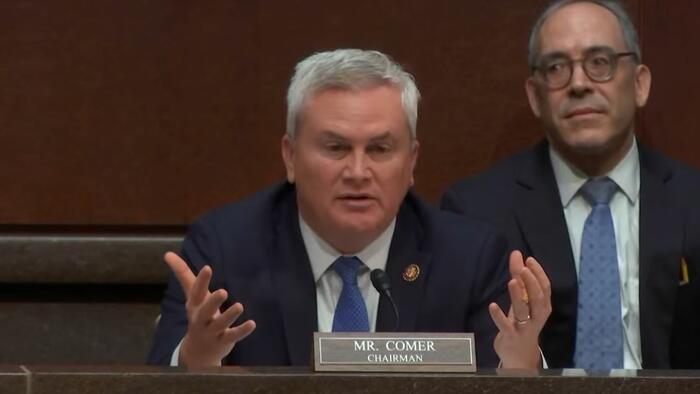


A report released by the House Oversight and Accountability Committee on Wednesday paints a damning picture of federal telework policies, accusing the Biden administration of prioritizing union demands over taxpayer interests and wasting billions of dollars on underutilized office space.
The 30-page report, released ahead of a hearing led by Committee Chairman Rep. James Comer (R-KY), slams the continuation of widespread work-from-home arrangements that surged during the COVID-19 pandemic. The findings indicate that many federal employees remain remote or telework regularly, leaving federal office buildings largely empty.
“The Biden-Harris administration has ceded too much authority to the federal union bosses, allowing their preference to work from home to take precedence over fulfilling agencies’ missions and serving the American people,” the report states.
The committee’s analysis revealed that of the 2.28 million federal civilian employees, roughly 228,000 are never required to report to the office. The remaining 1.1 million employees eligible for telework spend an average of only three days per week in the office.
According to the report, teleworking feds "must report to the office on occasion," whereas "remote employees never need to show up to work," Just the News reports.
Federal agencies such as the Department of Health and Human Services (HHS) and the General Services Administration (GSA) have seen dramatic increases in remote work since 2019. According to the report:
The report also highlights an alarming trend of unused office space. A Government Accountability Office (GAO) study from July 2023 "found that 17 of the 24 federal agencies used on average an estimated 25 percent or less of the capacity of their headquarter buildings," with some agencies reporting occupancy rates as low as 9%. Despite this, the federal government spends approximately $7 billion annually to lease and maintain office spaces.
During the hearing, Comer criticized federal agencies for spending $3.3 billion on furniture for offices that remain mostly empty. He singled out GSA Administrator Robin Carnahan, noting that she had worked from the agency’s Washington, D.C. headquarters for only 64 days over a 12-month period, opting instead to telework from Missouri.
The report also accuses the Biden administration of locking in long-term collective bargaining agreements that cement telework arrangements for years to come. In November, Social Security Administration (SSA) Commissioner Martin O’Malley approved a deal ensuring telework eligibility for 42,000 SSA employees through 2029, shortly before stepping down to pursue a role as Democratic National Committee chair.
"The outgoing Biden-Harris Administration entered into long-term [collective bargaining agreements] with federal employee unions that limit management authority through unprecedented concessions, including guaranteeing telework for federal bureaucrats," reads the report.
The American Federation of Government Employees (AFGE), the largest federal employee union, issued a sharp rebuke of the report ahead of the committee’s hearing:
"As a preliminary matter, AFGE is compelled to note that the title of today’s hearing unfortunately distorts how telework fits into larger work practices and protocols at federal agencies in order to unjustly criticize federal employees. Hardworking, dedicated federal employees should not be derided as ‘stay-at-home workers.’ Our members perform vital roles in public safety, law enforcement, and health care – including providing care for active-duty military and millions of veterans. The majority of our members were ineligible for telework even when the pandemic was at its worst and no vaccines or treatments were available. Many members died of COVID during this period, likely contracted while performing their work for the American people. For many thousands of our members, it is thus bitterly ironic to now castigate the ‘stay-at-home federal workforce."
The union further noted that many telework-eligible roles have continued to meet or exceed performance goals, arguing that flexible work arrangements can help recruit and retain top talent.
President-elect Donald Trump has pledged to bring federal employees back to their offices and overhaul telework policies. The House Oversight Committee report outlines nine recommendations to rein in remote work, including (via Just the News):
Comer emphasized that these reforms are crucial to restoring public trust in government.
“The lights may be on in federal buildings, but too many federal bureaucrats continue to work from home,” Comer said. “
"President Trump was elected in a landslide to bring accountability to Washington," Comer continued.
"Our report not only identifies the many problems with massive federal telework but also proposes solutions to get federal employees back to their offices, dispose of unused and vacant federal property, and prioritize the needs of the American people over the wants of federal bureaucrats. We look forward to working with President Trump and his administration to ensure the federal bureaucracy is fully accountable to the American people."
